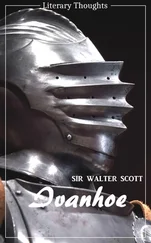line 406.Reference to Cicero’s cedant arma togae , a relic of an attempt at verse.
line 414. ‘Angus was an old man when the war against England was resolved upon. He earnestly spoke against that measure from its commencement; and, on the eve of the battle of Flodden, remonstrated so freely upon the impolicy of fighting, that the King said to him, with scorn and indignation, “if he was afraid, he might go home.” The Earl burst into tears at this insupportable insult, and retired accordingly, leaving his sons, George, Master of Angus, and Sir William of Glenbervie, to command his followers. They were both slain in the battle, with two hundred gentlemen of the name of Douglas. The aged Earl, broken-hearted at the calamities of his house and his country, retired into a religious house, where he died about a year after the field of Flodden.’-SCOTT.
Stanza XV. lines 415-20. Cp. description of Sir H. Osbaldistone, ‘Rob Roy,’ chap. vi.
line 429. ‘The ruins of Tantallon Castle occupy a high rock projecting into the German Ocean, about two miles east of North Berwick. The building is not seen till a close approach, as there is rising ground betwixt it and the land. The circuit is of large extent, fenced upon three sides by the precipice which overhangs the sea, and on the fourth by a double ditch and very strong outworks. Tantallon was a principal castle of the Douglas family, and when the Earl of Angus was banished, in 1527, it continued to hold out against James V. The King went in person against it, and for its reduction, borrowed from the Castle of Dunbar, then belonging to the Duke of Albany, two great cannons, whose names, as Pitscottie informs us with laudable minuteness, were “Thrawn mouth’d Meg and her Marrow”; also, “two great botcards, and two moyan, two double falcons, and four quarter falcons”; for the safe guiding and re-delivery of which, three lords were laid in pawn at Dunbar. Yet, notwithstanding all this apparatus, James was forced to raise the siege, and only afterwards obtained possession of Tantallon by treaty with the governor, Simon Panango, When the Earl of Angus returned from banishment, upon the death of James, he again obtained possession of Tantallon, and it actually afforded refuge to an English ambassador, under circumstances similar to those described in the text. This was no other than the celebrated Sir Ralph Sadler, who resided there for some time under Angus’s protection, after the failure of his negotiation for matching the infant Mary with Edward VI. He says, that though this place was poorly furnished, it was of such strength as might warrant him against the malice of his enemies, and that he now thought himself out of danger. (His State papers were published in 1810, with certain notes by Scott.)
‘There is a military tradition, that the old Scottish March was meant to express the words,
“Ding down Tantallon,
Mak a brig to the Bass.”
‘Tantallon was at length “dung down” and ruined by the Covenanters; its lord, the Marquis of Douglas, being a favourer of the royal cause. The castle and barony were sold in the beginning of the eighteenth century to President Dalrymple of North Berwick, by the then Marquis of Douglas.’-SCOTT.
In 1888, under the direction of Mr. Walter Dalrymple, son of the proprietor, certain closed staircases in the ruins were opened, and various excavations were made, with the purpose of discovering as fully as possible what the original character of the structure had been. These operations have added greatly to the interest of the ruin, which both by position and aspect is one of the most imposing in the country.
line 432. ‘A very ancient sword, in possession of Lord Douglas, bears, among a great deal of flourishing, two hands pointing to a heart which is placed betwixt them, and the date 1329, being the year in which Bruce charged the Good Lord Douglas to carry his heart to the Holy Land. The following lines (the first couplet of which is quoted by Godscroft, as a popular saying in his time) are inscribed around the emblem:-
“So mony guid as of ye Dovglas beinge,
Of ane surname was ne’er in Scotland seine.
I will ye charge, efter yat I depart,
To holy grawe, and thair bury my hart;
Let it remane ever BOTHE TYME AND HOWR,
To ye last day I sie my Saviour.
I do protest in tyme of al my ringe,
Ye lyk subject had never ony keing.”
‘This curious and valuable relic was nearly lost during the Civil War of 1745-6, being carried away from Douglas Castle by some of those in arms for Prince Charles. But great interest having been made by the Duke of Douglas among the chief partisans of the Stuart, it was at length restored. It resembles a Highland claymore, of the usual size, is of an excellent temper, and admirably poised.’-SCOTT.
Stanza XVI. line 461. Scott quotes:―
‘O Dowglas! Dowglas
Tender and trew.’- The Houlate .
line 470. There are two famous sparrows in literature, the one Lesbia’s sparrow, tenderly lamented by Catullus, and the other Jane Scrope’s sparrow, memorialised by Skelton in the ‘ Boke of Phyllyp Sparowe.’
line 475. The tears of such as Douglas are of the kind mentioned in Cowley’s ‘Prophet,’ line 20:-
‘Words that weep, and tears that speak.’
Stanza XVII. line 501. ‘The ancient cry to make room for a dance or pageant.’-SCOTT.
Cp. Romeo and Juliet, i. 5. 28: ‘A hall! a hall! give room,’ &c.
line 505. The tune is significant of a Scottish invasion of England. See Scott’s appropriate song to the ‘ancient air,’ ‘Monastery,’ xxv. Reference is made in I Henry II, ii. 4. 368, to the head-dress of the Scottish soldiers, when Falstaff informs Prince Hal that Douglas is in England, ‘and a thousand blue-caps more.’
Stanza XIX. line 545. Many of the houses in Old Edinburgh are built to a great height, so that the common stairs leading up among a group of them have sometimes been called ‘perpendicular streets.’ Pitch, meaning ‘height,’ is taken from hawking, the height to which a bird rose depending largely on the pitch given it.
Stanza XX. line 558. St. Giles’s massive steeple is one of the features of Edinburgh. The ancient church, recently renovated by the munificence of the late William Chambers, is now one of the most imposing Presbyterian places of worship in Scotland.
line 569. For bownesee above, IV. 487.
line 571. A certain impressiveness is given by the sudden introduction of this pentameter.
Stanza XXI. Jeffrey, in reviewing’ Marmion, ‘fixed on this narrative of the Abbess as a passage marked by ‘flatness and tediousness,’ and could see in it ‘no sort of beauty nor elegance of diction.’ The answer to such criticism is that the narrative is direct and practical, and admirably suited to its purpose.
line 585. Despiteously, despitefully. ‘Despiteous’ is used in ‘Lay of the Last Minstrel,’ V. xix. Cp. Chaucer’s ‘Man of Lawe,’ 605 (Clarendon Press ed.):-
‘And sey his wyf despitously yslayn.’
line 587. ‘A German general, who commanded the auxiliaries sent by the Duchess of Burgundy with Lambert Simnel. He was defeated and killed at Stokefield. The name of this German general is preserved by that of the field of battle, which is called, after him, Swart-moor.-There were songs about him long current in England. See Dissertation prefixed to RITSON’S Ancient Songs , 1792, p. lxi.’-SCOTT.
Читать дальше






